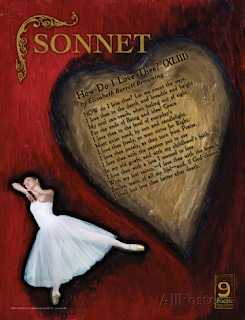Sonnet
It belongs to the same form of lyrical poetry as lyrics. But it defines in pattern; it must follow a definite pattern, written in accordance with
ser rules. Its origin traced to an Italian poet of the fourteenth century called Petrarch. The number of lines in the sonnet is limited to fourteen divided in two. The first eight is called octave and the last six is called sestet. It was introduced to England in the sixteenth century by Sir Thomas Wyatt and "The Earl of Surry". They slightly varied the Petrarchan form by dividing the fourteen lines into three groups of four (called quatrain) and a couplet at the end. The meter they employed was the lambic pentameter.
The greatest writer of al who established the new tradition was Shakespeare and because of him the form came to be termed Shakespearian. The best known among the poets who preferred to stick to the original Petrarchan form is Milton. The rhyme scheme among them within the context of the octave and sestet division is found to vary in numerous ways. The most common schemes are as follows: abba abba cde cde: abba abba cdcdcd: abba abba cod cod: abba abba cddccd.
The sonnet as a form was at the peak of its popularity in the sixteenth century during the reign of Elizabeth I. poet after poet produced in this age collections of sonnet called sequences, trying to unfold a connected story of which each individual sonnet provided a glimpse. The fashion started with the publication in 1592 of Philip Sidney's "Astrophel and Stella". It was followed by about twenty sequences of the same kind.
The best known are "Amoretti" by Spenser, "Idea's Mirror" by Drayton, "Delia by Samuel Daniel and the collection without a title-by Shakespeare
It belongs to the same form of lyrical poetry as lyrics. But it defines in pattern; it must follow a definite pattern, written in accordance with
ser rules. Its origin traced to an Italian poet of the fourteenth century called Petrarch. The number of lines in the sonnet is limited to fourteen divided in two. The first eight is called octave and the last six is called sestet. It was introduced to England in the sixteenth century by Sir Thomas Wyatt and "The Earl of Surry". They slightly varied the Petrarchan form by dividing the fourteen lines into three groups of four (called quatrain) and a couplet at the end. The meter they employed was the lambic pentameter.
The greatest writer of al who established the new tradition was Shakespeare and because of him the form came to be termed Shakespearian. The best known among the poets who preferred to stick to the original Petrarchan form is Milton. The rhyme scheme among them within the context of the octave and sestet division is found to vary in numerous ways. The most common schemes are as follows: abba abba cde cde: abba abba cdcdcd: abba abba cod cod: abba abba cddccd.
The sonnet as a form was at the peak of its popularity in the sixteenth century during the reign of Elizabeth I. poet after poet produced in this age collections of sonnet called sequences, trying to unfold a connected story of which each individual sonnet provided a glimpse. The fashion started with the publication in 1592 of Philip Sidney's "Astrophel and Stella". It was followed by about twenty sequences of the same kind.
The best known are "Amoretti" by Spenser, "Idea's Mirror" by Drayton, "Delia by Samuel Daniel and the collection without a title-by Shakespeare

تعليقات
إرسال تعليق